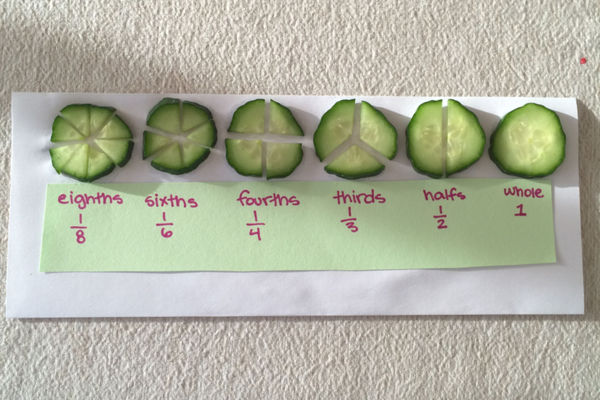Make fractions with food
Use everyday food like fruit, crackers, or sandwich slices to build and compare fractions by dividing, labeling, and recording equal parts.



Step-by-step guide to make fractions with food
Teach Fractions 🍕 Easily to Your Child | Fun & Visual Math Learning for Kids📏
Step 1
Gather all the materials and bring them to a clean table.
Step 2
Wash your hands well with soap and water.
Step 3
Rinse any fruit you will cut under running water.
Step 4
Pick one food item to use first and put it on a plate.
Step 5
Decide which fraction you want to make such as 1/2 1/3 or 1/4 and say your choice out loud.
Step 6
Ask an adult to cut your chosen food into that many equal parts.
Step 7
Write the fraction in numerator slash denominator form on a small piece of paper.
Step 8
Place the paper fraction next to the group of pieces so it matches the food parts.
Step 9
Pick a second food item and put it on another plate.
Step 10
Ask an adult to cut the second food into a different number of equal parts.
Step 11
Line up one piece from the first food next to pieces from the second food to compare sizes and count how many small pieces equal one larger piece.
Step 12
Write down which fraction is larger or how many small pieces make one larger piece.
Step 13
Draw both fraction groups on your paper and color them to match the real food.
Step 14
Share your finished fraction creation on DIY.org
Final steps
You're almost there! Complete all the steps, bring your creation to life, post it, and conquer the challenge!


Help!?
What can we use if we don't have the exact foods, plates, or an adult to cut the pieces as the instructions ask?
If you don't have fresh fruit, plates, or an adult to cut, use pre-sliced cheese or crackers on a paper plate and write the fraction on the small piece of paper just like the instructions direct.
What should we do if the adult's cuts aren't equal and the pieces don't match when we try to compare sizes?
If pieces aren't equal after the step 'Ask an adult to cut...', draw guidelines on the food or use a ruler or cookie-cutter templates so the parts are the same size before you place the paper fraction next to them.
How can we change the activity to suit a toddler versus an older child?
For toddlers keep it simple by using whole grapes or banana halves and focus on saying the fraction aloud and placing the paper fraction next to pieces, while older kids can cut foods into 5–8 parts, write which fraction is larger, and draw more detailed colored fraction diagrams as the instructions suggest.
How can we make the activity more fun or personal after drawing and coloring the fraction groups?
To enhance the activity, let the child create a 'fraction snack' by combining specific numbers of pieces from each food, label each ingredient with a paper fraction, photograph the layout, and then share the finished fraction creation on DIY.org as the final step.
Watch videos on how to make fractions with food
Pizza Fractions Activity | Learn Fractions | Educational Videos for Children
Facts about fractions and hands-on math
🍕 A pizza is often cut into 6 or 8 slices — perfect for showing sixths and eighths with a tasty example.
🍎 Cut an apple in half and you get 2 equal parts called halves — a super-simple fraction demo.
🥪 Everyday foods like crackers, sandwiches, and orange slices make learning fractions memorable — and snackable!
🧩 Teachers frequently use hands-on manipulatives (including food) because touching and dividing helps kids grasp fractions.
🧮 The word "fraction" comes from Latin roots meaning "to break" — fractions are broken parts of a whole.
How do I make fractions with food so my child can divide, label, and record equal parts?
What materials do I need to make fractions with food?
What ages is making food-based fractions suitable for?
What are the benefits and safety tips for teaching fractions with food?


One subscription, many ways to play and learn.
Only $6.99 after trial. No credit card required



